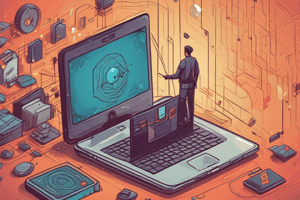Podcast
Questions and Answers
What are some common motivations behind committing computer crimes, and how do they differ from traditional crimes?
What are some common motivations behind committing computer crimes, and how do they differ from traditional crimes?
Motivations include financial gain, espionage, revenge, or causing disruption. They differ due to reliance on technology and the potential for anonymity and remote execution.
Explain the concept of 'social engineering' in the context of computer crimes. Provide a real-world example of how it could be used.
Explain the concept of 'social engineering' in the context of computer crimes. Provide a real-world example of how it could be used.
Social engineering is manipulating individuals into divulging confidential information. Example: posing as IT support to gain login credentials.
How does the international nature of the internet complicate the prosecution of computer crimes?
How does the international nature of the internet complicate the prosecution of computer crimes?
Jurisdictional issues arise when crimes occur across borders. Differing laws and extradition treaties can impede prosecution.
Describe the key differences between malware, viruses, and worms in terms of their propagation methods and impact on computer systems.
Describe the key differences between malware, viruses, and worms in terms of their propagation methods and impact on computer systems.
What is a 'phishing' attack, and what are some common techniques used by cybercriminals to deceive individuals in such attacks?
What is a 'phishing' attack, and what are some common techniques used by cybercriminals to deceive individuals in such attacks?
Explain the role of firewalls in preventing unauthorized access to computer systems. What are their limitations?
Explain the role of firewalls in preventing unauthorized access to computer systems. What are their limitations?
What are the potential consequences of a Distributed Denial of Service (DDoS) attack on a website or online service?
What are the potential consequences of a Distributed Denial of Service (DDoS) attack on a website or online service?
How can encryption be used to protect sensitive data stored on a computer or transmitted over a network?
How can encryption be used to protect sensitive data stored on a computer or transmitted over a network?
What are the key principles of data privacy, and how do they relate to the prevention of computer crimes involving personal information?
What are the key principles of data privacy, and how do they relate to the prevention of computer crimes involving personal information?
Explain the difference between symmetric and asymmetric encryption. Give a use case example for each.
Explain the difference between symmetric and asymmetric encryption. Give a use case example for each.
What measures can individuals take to protect themselves from identity theft and online fraud?
What measures can individuals take to protect themselves from identity theft and online fraud?
Describe the role of penetration testing in identifying vulnerabilities in computer systems. What are the ethical considerations?
Describe the role of penetration testing in identifying vulnerabilities in computer systems. What are the ethical considerations?
How do laws like the Computer Fraud and Abuse Act (CFAA) in the US and similar legislation in other countries aim to combat computer crimes?
How do laws like the Computer Fraud and Abuse Act (CFAA) in the US and similar legislation in other countries aim to combat computer crimes?
Explain the concept of a 'zero-day' vulnerability. Why are zero-day vulnerabilities particularly dangerous?
Explain the concept of a 'zero-day' vulnerability. Why are zero-day vulnerabilities particularly dangerous?
What are the common types of evidence collected in computer crime investigations, and how is this evidence typically handled to ensure its admissibility in court?
What are the common types of evidence collected in computer crime investigations, and how is this evidence typically handled to ensure its admissibility in court?
How does the use of cloud computing introduce new security challenges compared to traditional on-premises infrastructure?
How does the use of cloud computing introduce new security challenges compared to traditional on-premises infrastructure?
What is ransomware, and what steps should an organization take to prevent or recover from a ransomware attack?
What is ransomware, and what steps should an organization take to prevent or recover from a ransomware attack?
Explain the concept of 'two-factor authentication' (2FA) and why it is considered a best practice for enhancing account security.
Explain the concept of 'two-factor authentication' (2FA) and why it is considered a best practice for enhancing account security.
How can businesses safeguard their data and networks during remote work arrangements? What are some key considerations?
How can businesses safeguard their data and networks during remote work arrangements? What are some key considerations?
What are the implications of the Internet of Things (IoT) for computer security? Provide one example of a security risk associated with IoT devices.
What are the implications of the Internet of Things (IoT) for computer security? Provide one example of a security risk associated with IoT devices.
Flashcards
Computer Crimes
Computer Crimes
Illegal activities conducted through computers or networks.




